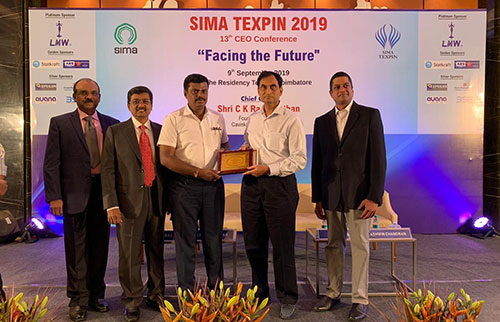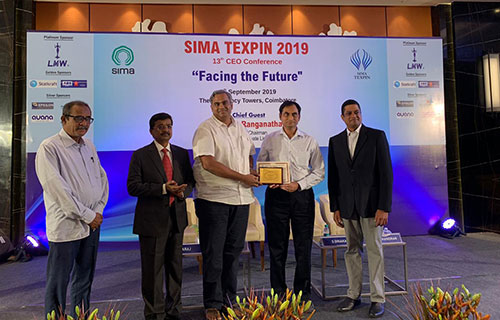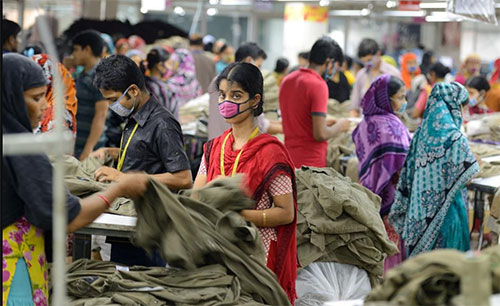FW
Bangladesh garment shipments to the US increased three per cent this year compared to last year. Indeed, the US-China trade war has helped a lot. Also, automation in production of garments and distribution too helped. Garment businesses feel they cannot go far with traditional marketing and production in factories and they should be more technology dependent. Some Bangladesh exporters are already in business with Amazon.
Though Bangladesh is benefitting from the trade disputes, the biggest gainer is Vietnam, which received more work orders. The biggest challenges for Bangladesh are fast adoption of automation and exploration of marketing avenues alongside meeting shortages of skilled manpower. Bangladesh’s apparel manufacturers are facing tough competition in export destinations due to a devaluation in the currencies of all emerging countries. The country’s readymade garment sector has already lost its competitive edge in global markets due to a rise in production costs. A lot of money has been spent in improving safety standards to ensure a safe environment for workers. Also manufacturers have to implement the new wage structure from December. Last year shipments to the US, Bangladesh’s largest export destination, actually decreased two per cent.
Exhibitors in the Fancy Yarn Zone of the Yarn Expo Autumn 2019 will increase by 30 per cent from previous year and feature 118 exhibitors. The expo will also launch a new display area, Fancy Yarn Vision, within the zone. Fancy Yarn Vision will be open throughout the three days of the fair, from September 25-27, 2019 and feature advanced technologies and products from Chinese and overseas exhibitors. The zone has been gathering momentum in recent editions, as the fair is recognised for its all-encompassing range of yarn and fibre products, from natural to synthetic.
Debut of Fancy Yarn Vision display area (booth No. A02), supports growing demand for fancy yarn. With irregularities introduced during spinning, fancy yarn products add value in the form of color, texture and function, making it suitable for creating stand-out fashion and other finished textile products. The display area will offer exhibitors a platform to display their latest collections to a wider audience, while interested buyers can then streamline their sourcing trip by heading directly to individual booths.
The increase in fancy yarn exhibitors further reflects the fair’s commitment to meeting a variety of sourcing needs. Innovative yarns are a key way for industry players to spin and weave their way into the market for high performance. Sourcing options for innovative fancy yarn are now better than ever, due to increased growth in fancy yarn trade between Europe and Asia, which has opened up a vast new market that encourages competitive innovation. As Asia’s leading yarn and fibre trading platform, Yarn Expo has become a key event for exhibitors to reveal their latest technology. More functional innovation can be found from highlighted Korean exhibitors:
Yarn Expo is organised by Messe Frankfurt (HK) Ltd and the Sub-Council of Textile Industry, CCPIT. Yarn Expo Autumn 2019 will be held in Hall 8.2 at the National Exhibition and Convention Center (Shanghai), concurrently with the 25th Autumn Edition of Intertextile Shanghai Apparel Fabrics, as well as CHIC and PH Value.
"At the 13th CEO Conference held on September 09, 2019 at The Residency Towers, Coimbatore, top 10 performing group of mills were awarded with the SIMA Technofacts Award for the year 2018-19. The awards were given away by the Chief Guest, CK Ranganathan, Founder Chairman, Cavinkare"
At the 13th CEO Conference held on September 09, 2019 at The Residency Towers, Coimbatore, top 10 performing group of mills were awarded with the SIMA Technofacts Award for the year 2018-19. The awards were given away by the Chief Guest, CK Ranganathan, Founder Chairman, Cavinkare

GHCL Unit II and I were ranked on the first and second position. The Unit II of the Sri Jayajothi & Co were ranked on the third, ninth and fourteenth position. The fourth and seventh ranks were occupied by the M Unit of the Precot Meridian while its C Unit bagged the fifth rank. The sixth rank was bagged by Premiere Cotton Textiles, the eighth by Sambandham Spinning Mills, the tenth rank by Jagannath Textile Company, eleventh by Loyal Textiles, twelfth by Premier Spinning & Weaving Mills; thirteenth by the Unit II of Jay Textiles and fifteenth by Shri TP Textiles.

The awards were given away by CK Ranganathan, Founder Chairman, Cavinkare accompanied by P Nataraj, Chairman, SIMA; Ashwin Chandran, Vice-Chairman, SIMA and S Dinakaran, Jury Chairman, Technofacts Awards.
Italian Converter has launched E.C.O. Kosmos, a new range of green materials. E.C.O. stands for Ecologic, Conversion, Optimisation, three unique concepts and values that embody Italian Converter DNA: sustainability, transformative process and quality improvement. For over 25 years, Italian Converter has been creating high-quality materials for some of the leading fashion and accessories brands.
The collection offers complete and balanced range sustainable materials - from natural to eco high tech onesthat are transformed, enriched and valued in 9 high-tech cuttingedge innovations thanks to the Italian Converter expertise. The natural line starts from bases of cotton bonded with Amni Soul Eco®, an enhanced •polyamide 6.6 that degrades within 5 years instead of decades, as other conventional ones do. The stretch innovations start from bases in GRS-certified Newlife™, a cutting-edge premium •Recycled polyester created using a High-Tech Conversion Model.
Through a mechanical process, used plastic bottles are turned into top-quality polymer and yarn which is 100 per cent traceable and 100 per cent Made in Italy. The whole process takes place within a 100 sq. km area in Piedmont in Northern Italy. Toupe and brik red E.C.O. Graffiti (100 per cent linen) on E.C.O. Aurora (cotton and Amni Soul Eco®) All the references make use only of water-based resins and Standard 100 by OEKO-TEX® certified dying. The result is resistant and transpiring solutions which come with bold and high-performing features, with a soft touch or even with a silky, yet strong, and enveloping feel. The designs range from rustic to contemporary and nod to jacquard, ‘authentic look’ and ‘drill’ hints. E.C.O. Kosmos reflects design, innovation and responsible values, as well as 100% Italian Converter know-how.
"From top fashion brands like H&M and Gucci to small fabric companies, all fashion lovers are making conscious efforts to reduce the colossal amount of waste filling our landfills every year. Luxury brand LVMH Moët Hennessy Louis Vuitton recently signed a five-year biodiversity partnership with UNESCO, committing to an ambitious set of environmental goals."
 From top fashion brands like H&M and Gucci to small fabric companies, all fashion lovers are making conscious efforts to reduce the colossal amount of waste filling our landfills every year. Luxury brand LVMH Moët Hennessy Louis Vuitton recently signed a five-year biodiversity partnership with UNESCO, committing to an ambitious set of environmental goals.
From top fashion brands like H&M and Gucci to small fabric companies, all fashion lovers are making conscious efforts to reduce the colossal amount of waste filling our landfills every year. Luxury brand LVMH Moët Hennessy Louis Vuitton recently signed a five-year biodiversity partnership with UNESCO, committing to an ambitious set of environmental goals.
However, adopting systems and practices that make a difference, is easier said than done. As the annual ‘Pulse of the Fashion Industry’ report indicates, the rate of this improvement is slow as economic and technological issues prove a major hurdle. The report says, around 15 per cent of the global fashion industry is yet to embrace any responsible practices.
Sustainability penetrates the fashion industry
As per Nate Herman, Vice President of the supply chain at the American Apparel and Footwear Association (AAFA), sustainability was first adopted by outdoor clothing makers. The trend has now penetrated to every part of the industry as brands have learned new ways to reuse their products.
(AAFA), sustainability was first adopted by outdoor clothing makers. The trend has now penetrated to every part of the industry as brands have learned new ways to reuse their products.
Unifi, a North Carolina-based manufacturer of synthetic yarns, launched a recycled polyester yarn, Repreve, in 2007. The brand opened its own recycling center in Yadkinville, North Carolina, in 2010. In 2014, it expanded its operations and opened a Repreve-dedicated bottle processing centre in 2016. In 2018, the company partnered with the Mercedes Benz Stadium, Georgia Aquarium, and Atlanta International Airport to recycle bottles. Till date, the company has recycled 14 billion plastic bottles into jackets.
Demand for recycled materials fuels expansion plans
Textile manufacturers are expanding their operations on basis of demand for these recycled materials. Aquafil, an international textiles producer with headquarters in Italy, makes and markets Econyl, a nylon yarn made from industrial and household waste. This yarn, manufactured from materials as diverse as fishing nets and discarded carpets, has been used by more than 600 fashion brands, including high-end designers like Gucci and Stella McCartney. Last year, Aquafil recycled five million pounds of nylon and other materials. The company now aims to double this quantity by 2021.
Growing preference for green chemicals
Fashion companies are no longer relying on harmful chemicals like mercury dyes and formaldehyde finishes. Some of them are recycling and reusing petroleum-based products such as polyester fabrics. In 2007, Patty Grossman with her sister, Leigh Ann Van Dusen, developed Two Sisters Ecotextiles, an eco-friendly textiles manufacturing company based in Seattle. The company only produces natural and cellulosic fibres. Its certified dyes don’t have too much copper in them.
The 20th edition of AAFA published its list of restricted substances earlier this year. The list features 250 chemicals. However, according to Herman, many of these alternatives haven’t been tested yet. Brands have thus failed in their efforts to decrease the environmental footprint around synthetics.
India ITME Society, the apex non-profit industry body from India organised a press conference in Ghana to promote its international events ITME Africa 2020. The India ITME Society, strives to support and serve the textile industry through exhibitions, events, trade promotions, education scholarships, student placements etc.
The society plays a pivotal role in strengthening the domestic as well as International Textile Industry by facilitating exchange of knowledge and technology transfer. However, with specific objective of connecting to Africa, India ITME Society is organising an international business exhibition which focuses on business opportunities in the textile sector across the entire Africa, initialising technological revolution for textile industry, thereby creating new market opportunities for textile & textile engineering industry.
The prestigious international textile engineering exhibition is supported by Textiles Ministry, Commerce & Industry Ministry, Engineering Exports promotion council (EEPC), Federal Republic of Ethiopia, Ethiopian Textile Industry Development Institute, International Trade Centre (ITC), Botswana Textile & Clothing Association (BTCA) & Botswana Trade & Investment Centre (BITC), apart from many Indian and overseas Industry associations from Ethiopia.
ITME Africa 2020 has 220 Exhibitors with country pavilions from India, China, Italy, Switzerland, Turkey and participation from additional Countries including South Africa, United Kingdom, Austria, Belgium, Egypt, Ethiopia & Ghana.
Cotton Corporation of India (CCI) is planning to procure raw cotton at MSP from the Punjab market. CCI will procure this cotton directly from farmers without any middlemen. Last time, the central agency had done the procurement in 2014-15. The agency will have to settle issues with the strong lobby of arhtiyas in Punjab, who are opposed to direct procurement.
The Union Government had announced the MSP of long staple (27.5-28.5mm) cotton, commonly grown in Punjab, at Rs 5,450 per quintal for 2019-20 (September 1-August 31). After facing inclement weather in July, cotton crop is progressing well and growers feel if no more rains lash the region in the coming days the crop is expected to remain good and they may get a yield of nearly 770kg of lint per hectare.
Raw cotton arrivals have been reported in small quantities in some mandis in the last two days and have fetched rates above the MSP. These are expected to decline when the arrivals increase in the coming weeks.
Spinning mills in India are facing a sharp decline in demand from fabric and garment manufacturers, forcing them to cut their production. They are also going in for business consolidation, mainly by laying off labor. One-third of the spinning mills’ installed capacity remains unutilised due to the weak demand. This is because India’s biggest market for yarn — China — has started sourcing cotton from Vietnam. Demand from China has fallen by 35 per cent. Also, the country’s competitiveness at the global level is low because of embedded taxation.
Demand for cotton is low as the textile sector is facing a recession as bad as in 2008. Due to weakening demand by spinning mills, the produce is selling at prices below the minimum support price. Apart from the domestic market, exports of garments are also down by 20 to 30 per cent. Since manufacturers opt for production after getting export orders, they have been forced to restrict production due to weak demand. On the domestic front also, sales are not picking up despite the festival season’s having started. Retailers are not willing to keep more stocks. As a result, manufacturers have little choice but to go in for consolidation and labor layoffs.
LVMH’s brand Louis Vuitton plans to expand its production to meet the growing demand in markets like China. For this, the brand will hire another 1,500 manufacturing staff in France by 2022. It will also add another site next to its newly opened workshop outside the village of Beaulieu-Sur-Layon in western France. Louis Vuitton has three production sites in the United States that cater to U.S. market. It currently aims to fine tune its manufacturing process to limit excess inventories.
LVMH's biggest revenue driver the brand makes the bulk of its trademark leather and canvas handbags in its home market, where it employs around 4,300 people in 16 leather goods workshops. It is currently riding high on strong appetite among young Chinese consumers for branded goods.
India’s cotton yarn exports slumped 44 per cent in July 2019 compared to July 2018. The downward trend continued in the first week of August as well. Between April and July, cotton yarn exports fell nearly 35 per cent. Exports to China, Korea and Bangladesh are down. However, competing countries are increasing their share in exports to markets such as China, South Korea, and Turkey.
While India was the second largest exporter of textile and clothing in 2014-2017, it has come down to fifth position now. The space vacated by China in textile and clothing products has been largely consumed by Bangladesh, Vietnam, Pakistan and other least developed countries. While Indian yarn incurs 3.5 per cent to four per cent duty in China, the levy is nil for yarn exported to China from Vietnam, Bangladesh and Pakistan. India is now seen as a gap-filling segment and not as the main feeder. It is mainly because of tariffs.
The industry wants the three per cent interest equalisation to be extended to cotton yarn. Also the rebate of state and central taxes and levies scheme for garments should be extended to yarn and fabrics too. Further, it wants the raw materials for manmade fiber and viscose yarn to be available at international prices so that more spindles convert to synthetic yarn.












